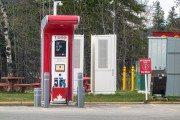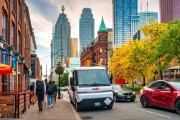Improving transit on busy routes is not a new idea. Cities around the world have implemented measures to make transit run more smoothly — whether it's just to shave a few minutes off of travel times, increase safety for pedestrians, or create a lively public space connected by transit. As I discussed in my last blog, Toronto has the opportunity to improve transit on King Street, while creating a better public space.
Below are some examples from major cities that have implemented various degrees of transit separation and how it improved their traffic flow. Some examples, like Portland Transit Mall and Granville Mall, have existed since the 1980s, and are focused on attracting businesses and being a destination for pedestrians. Newer initiatives in New York and San Francisco aim to improve transit operations, and also incorporate street art and wide sidewalks to be a friendly, welcoming corridor for transit users and pedestrians.
Church Street (San Francisco, CA)

Description: In 2013 centre-running road lanes were painted bright red to demarcate transit- and taxi-only lanes for three blocks of Church Street. The project also restricted left turns by private vehicles.
Goal and Results: The goal of the project was to improve service reliability and reduce travel times. San Francisco Municipal Transportation Agency (SFMTA) reported that travel times were reduced by 14 per cent, and the travel time reliability improved by 27 per cent. Drivers did not experience significant delays on the street and there were no significant increases in traffic volumes on parallel streets during the peak periods.
The success of the Church Street project led to the implementation of transit priority lanes on Market Street and Mission Street as well.
Portland Transit Mall (Portland, OR)

Description: 5th and 6th Avenues have two transit-only lanes and one lane for all modes for a 2.25 kilometre stretch. The transit mall has existed since 1977 and LRT was introduced in 2009.
Goal and Results: The goal of the project is to revitalize downtown through concentrating high-density offices around a high-quality transit spine. The transit mall has attractive, well-lit stations and public art. As businesses along the corridor develop and thrive, the transit corridor continues to be a dynamic area and destination for pedestrians.
Bus-only lanes (New York, NY)

Description: Starting in 2008, the city began introducing bus-only lanes on major transit corridors across the city. The transit prioritization project also included increased enforcement of vehicle infractions, bus stop consolidation and street re-design to allow cars to turn left without blocking buses.
Goals and Results: The goal was to accommodate forecasted ridership growth and reduce the number of cars that interfered with bus traffic. According to the City of New York, bus travel times were improved by 12-14 per cent on Livingston Street, and traffic infractions were reduced by over 50 per cent, meaning that fewer cars were blocking buses. Businesses were satisfied with fixed delivery windows during off peak periods and the provision of some parking. On 34th Street the city found that there were no significant congestion impacts of the transit-only lanes, meaning no new delays for drivers.
Granville Mall (Vancouver, BC)

Description: Since 1989, Granville Street has been transit-only for an 800-metre stretch. Cars are prohibited from driving on this segment; it is instead dedicated to cyclists and pedestrians.
Goals and Results: Granville Street is a major destination with shopping and bars. Prohibiting cars allows for 1,900 buses and trolleys to carry over 67,000 riders on a weekday. Since 1989, businesses continue to thrive on this pedestrian- and transit-only stretch. There has been a recent focus on revitalizing the street to ensure it remains an inviting destination for pedestrians and visitors.
Golden Mile (Wellington, NZ)

Description: The Golden Mile is a transit prioritization project covering multiple streets in downtown Wellington. Measures range from lowering speed limits to 30 kilometres per hour, limiting cars during peak periods or prohibiting cars altogether. The city also introduced bus-only lanes.
Goals and Results: Wellington City residents were largely supportive, with 68 per cent of residents approving of the transit prioritization measures. The initiative was successful with improved bus travel times. Part of the project's success was pairing the vehicular restrictions with streetscape improvements like sidewalk widening and added greenery.
These examples demonstrate that simple measures can be introduced to improve transit reliability, enhance the public realm, increase safety and support businesses. These projects all prove that relatively small investments in transit can result in big pay-offs for transit users, drivers and pedestrians.
Toronto has the opportunity to test ideas on King Street, observe how transit and the public realm can be improved, and use lessons learned to tweak transit priority measures or implement successful measures on other busy transit corridors. These global examples can be used to inspire solutions for segments of King Street.







